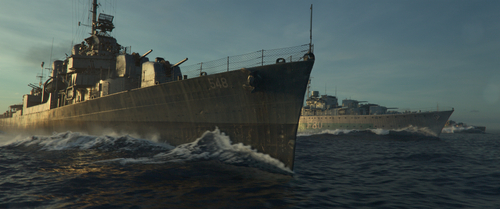Presentation

"Greyhound": A Dive Into the Depths of Colossal Photorealism
Event Type
Production Session
This session has been pre-recorded.
Production & Animation
Ultimate Supporter
Ultimate Attendee
Exhibitor Ultimate
TimeFriday, 13 August 202110am - 11am PDT
Location
DescriptionDerived from a novel called “The Good Shepherd” by C.S. Forester, "Greyhound" was adapted for the screen by Tom Hanks. The story follows the experience of U.S. Naval Commander Ernest Krause (played by Hanks) as he escorts a convoy across the Mid-Atlantic gap in 1942.
Visualizing this story brought complex but exciting challenges to the DNEG team. We had to deliver elaborate shots of WWII ships and submarines, produce ocean sims, enhance limited live-action set photography, and craft the North Atlantic around it — all while coming onto the film after principal photography had finished.
Once awarded to DNEG, "Greyhound’s" VFX work had an immediately tight timeframe. An early objective was to produce shot content that genuinely assisted the filmmakers in making confident narrative and editorial decisions. From our side at DNEG, this meant implementing efficient workflows that allowed a shot in layout to be passed quickly through the pipeline, all the way to producing a client deliverable with minimal repetitive human input. Although we were working with a short post-production period, we were able to allow the filmmakers a surprising amount of latitude by letting them view the impact of their decisions, not only as cheap low-fi renders but as lit, rendered, and composited sequences.
Authenticity is key for a show like this. A minute-by-minute account via radar plans was issued by production under the remit of a naval professional. This determined the weather conditions, ocean Beaufort, time of day, ship orientation, and course per shot. We mocked out all of these plans into one master scene in layout, and this gave us a shot-by-shot lighting timeline for the entire show.
The story required the portrayal of different hours (and subsequent weather changes) over a 24-hour period. To achieve this visualization, we used a specially built multi-camera rig which enabled us to shoot 360-degree time-lapses from dawn until dusk in high dynamic range. For nighttime battle sequences, we achieved photorealistic looks by using subtle moonlight, fire, flares, and gun-muzzle-flashes as light sources.
The story of "Greyhound" follows Allied convoys as they cross an oceanic zone known as the Black Pit, called so because it is an area out of range of protective air cover. Because of this, the digital recreation of the Mid-Atlantic gap was critical to visualizing the story.
The ocean itself also is critical in affecting how ships would move and react to changes in the weather. Using the Beaufort scale, DNEG was able to match the sea conditions to the film’s story beats. This, in turn, drove the animation of the ships, the water simulations, and the look of the shots. In "Greyhound," every shot that featured the North Atlantic as a background was a digital replacement.
Visualizing this story brought complex but exciting challenges to the DNEG team. We had to deliver elaborate shots of WWII ships and submarines, produce ocean sims, enhance limited live-action set photography, and craft the North Atlantic around it — all while coming onto the film after principal photography had finished.
Once awarded to DNEG, "Greyhound’s" VFX work had an immediately tight timeframe. An early objective was to produce shot content that genuinely assisted the filmmakers in making confident narrative and editorial decisions. From our side at DNEG, this meant implementing efficient workflows that allowed a shot in layout to be passed quickly through the pipeline, all the way to producing a client deliverable with minimal repetitive human input. Although we were working with a short post-production period, we were able to allow the filmmakers a surprising amount of latitude by letting them view the impact of their decisions, not only as cheap low-fi renders but as lit, rendered, and composited sequences.
Authenticity is key for a show like this. A minute-by-minute account via radar plans was issued by production under the remit of a naval professional. This determined the weather conditions, ocean Beaufort, time of day, ship orientation, and course per shot. We mocked out all of these plans into one master scene in layout, and this gave us a shot-by-shot lighting timeline for the entire show.
The story required the portrayal of different hours (and subsequent weather changes) over a 24-hour period. To achieve this visualization, we used a specially built multi-camera rig which enabled us to shoot 360-degree time-lapses from dawn until dusk in high dynamic range. For nighttime battle sequences, we achieved photorealistic looks by using subtle moonlight, fire, flares, and gun-muzzle-flashes as light sources.
The story of "Greyhound" follows Allied convoys as they cross an oceanic zone known as the Black Pit, called so because it is an area out of range of protective air cover. Because of this, the digital recreation of the Mid-Atlantic gap was critical to visualizing the story.
The ocean itself also is critical in affecting how ships would move and react to changes in the weather. Using the Beaufort scale, DNEG was able to match the sea conditions to the film’s story beats. This, in turn, drove the animation of the ships, the water simulations, and the look of the shots. In "Greyhound," every shot that featured the North Atlantic as a background was a digital replacement.
Panelists

